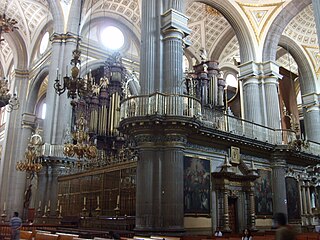Related Research Articles

Puebla, also known in Spanish as Puebla de Zaragoza, formally Heroica Puebla de Zaragoza and in colonial times as Puebla de los Ángeles, is the seat of Puebla Municipality. It is the fourth largest city in Mexico, in terms of population and economy, behind Mexico City, Monterrey, and Guadalajara. In addition to being the capital and largest city of the state of Puebla, and the second largest in colonial Mexico and the richest Catholic diocese. A colonial era planned city, it is located in (southern) Central Mexico on the main route between the capital, Mexico City, and Mexico's main Atlantic port, Veracruz—about 100 km (62 mi) east southeast of Mexico City and about 220 km (140 mi) west of Veracruz.

The music of Mexico is very diverse and features a wide range of musical genres and performance styles. It has been influenced by a variety of cultures, most notably the culture of the Europeans and Natives. Music was an expression of Mexican nationalism, beginning in the nineteenth century.
Francisco de Peñalosa was a Spanish composer of the middle Renaissance.
Manuel de Zumaya or Manuel de Sumaya was perhaps the most famous Mexican composer of the colonial period of New Spain. His music was the culmination of the Baroque style in the New World. He was the first person in the western hemisphere to compose an Italian-texted opera, entitled Partenope. Similar to Antonio Vivaldi, Zumaya was also a life-long, active Roman Catholic priest.

Juan Gutiérrez de Padilla was a Spanish composer of the Baroque period.
The villancico or vilancete was a common poetic and musical form of the Iberian Peninsula and Latin America popular from the late 15th to 18th centuries. With the decline in popularity of the villancicos in the 20th century, the term became reduced to mean merely "Christmas carol". Important composers of villancicos were Juan del Encina, Pedro de Escobar, Francisco Guerrero, Manuel de Zumaya, Juana Inés de la Cruz, Gaspar Fernandes, and Juan Gutiérrez de Padilla.
Juan Bautista Comes, aka per Valencian spelling Joan Baptista Comes, was a Spanish Baroque composer who was born and died in Valencia.

Puebla Cathedral is a Roman Catholic church in the city of Puebla's historic centre, in the state of Puebla, Mexico. It is a colonial cathedral, and is the see of the Roman Catholic Archdiocese of Puebla de los Ángeles. The cathedral's archbishop is Víctor Sánchez Espinosa. The cathedral is dedicated to the Immaculate Conception.
Francisco Valls or Francesc Valls was a Spanish composer, theorist and mestre de capella. Among his most known works are the mass Missa Scala Aretina and tract Mapa Armónico Práctico.
Juan Vásquez was a Spanish priest and composer of the Renaissance. He can be considered part of the School of Andalusia group of composers along with Francisco Guerrero, Cristóbal de Morales, Juan Navarro Hispalensis and others.
Rafael Antonio Castellanos was a Guatemalan classical composer. His style is that of the late Spanish baroque, pre-classical, and classical periods, with frequent reference to Guatemalan folk music idioms.
Manuel José de Quirós was an 18th-century Guatemalan composer.
José Eulalio Samayoa was a Guatemalan classical composer.
Pedro Bermúdez (1558–1605) was a Spanish composer and chapel master, who has been recognised as one of the most outstanding polyphonists in the New World, and who was active in Granada, Antequera, Cusco, Santiago de Guatemala, and Puebla.
Gaspar Fernandes (1566–1629) was a Portuguese-Mexican composer and organist active in the cathedrals of Santiago de Guatemala and Puebla de los Ángeles, New Spain.
Philippe Rogier was a Franco-Flemish composer of the Renaissance, active at the Habsburg court of Philip II in Spain. He was one of the last members of the Franco-Flemish school, in the closing days of the Renaissance period in music history, and was a prolific composer; however most of his music was lost in the destruction by fire of the library of John IV during the Lisbon earthquake of 1755.
Juan Hidalgo de Polanco was a Spanish composer and harpist who became the most influential composer of his time in the Hispanic world writing the music for the first two operas created in Spanish. He is considered by many to be the father of Spanish opera and of the zarzuela.

Antonio Sebastián Álvarez de Toledo y Salazar, 2nd Marquess of Mancera, Grandee of Spain was a Spanish nobleman and diplomat who served as Viceroy of New Spain from October 15, 1664, to December 8, 1673.
Sebastián Durón was a Spanish composer.
The Colonial Mexican Period lasted from 1521 to 1821 during the Vice-Regency of New Spain. The cultivation of European music began soon after the arrival of the Spanish, during the Late-Renaissance period of Western Music. Musical practices continually coincided with European tendencies throughout the subsequent Baroque and Classical music periods. It is important to note that while much music was fashioned in European style, uniquely Mexican hybrid works composed of native Mexican language and European musical practice, appeared as early as the sixteenth century, and throughout the colonial period.
References
- ↑ Turner, Bruno. Essay in booklet to Masterpieces of Mexican Polyphony (Hyperion CDH55317). 1990
- ↑ Recording, commentary, lyrics and translation, in Nueva España Close Encounters with the New World, 1590-1690 Boston Camerata - Joel Cohen CD Erato 2292 45977-2, reissued as Apex (Warner) 2564-62408-2 2006